Acer Predator XB271HK 27-inch UHD G-Sync Monitor Review
Gamers seeking Ultra HD resolution have few choices but an excellent new G-Sync monitor has just appeared from Acer, the XB271HK sporting a 27-inch AHVA screen. We’re checking it out in our lab today.
Why you can trust Tom's Hardware
Packaging, Physical Layout And Accessories
Our sample came in a box that had been shipped several times previously and was looking a bit worn but there wasn’t a scratch on the monitor or other contents. Rigid foam did its job protecting this premium display as did the double-corrugate cardboard carton.
Included cables are IEC for the internal power supply, DisplayPort, HDMI and USB 3.0. You also get a printed quick start guide. Additional drivers and a full user manual can be downloaded from Acer’s website. The base, upright and panel are packed separately and must be assembled. Once you bolt the base on, the stand snaps into place.
Product 360
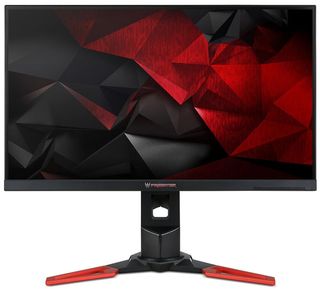
Acer doesn’t advertise the XB271HK as bezel-free but it is a flush design in which the anti-glare layer extends to the edge of the chassis exposing only a thin plastic edge. When the power is on, the image extends almost all the way out leaving just an 8mm border around the top and sides. The plastic trim across the bottom extends 22mm, enough to accommodate a Predator logo and the OSD control keys. They offer good feedback and click with precision. The power LED is a bright blue when turned on but can be dimmed or turned off.
The anti-glare layer is very aggressive in operation and imparts a barely perceptible texture to the image. It’s not something you’ll see in most content, but we were aware of it in some smooth-toned material.
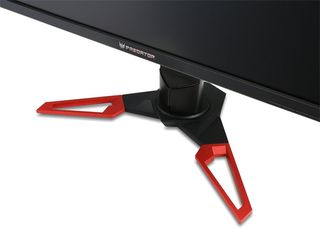
Acer has adopted the sci-fi boomerang design for the bases of all its Predator-series displays. The red parts are cast aluminum and the whole thing exudes quality. The upright is equally solid with firm movements. The panel will stay put without any annoying wobbles.
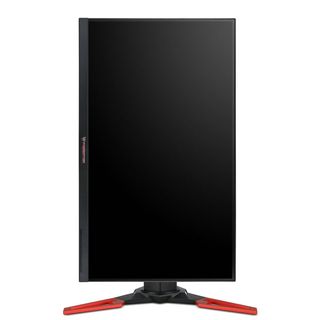
Positioning options include a portrait mode along with nearly six inches of height adjustment, not to mention generous tilt and swivel. The wide bottom bezel may dissuade those who wish to create a vertical multi-screen setup. If you go horizontal however, the XB271HK has one of the thinnest bezels we’ve ever seen.
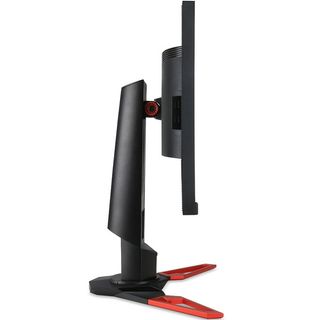
The panel appears slim but that’s mainly because of a prominent bulge in the center. It’s flat enough to wall-mount if you wish. On the right side are two USB ports with the remaining two on the bottom with the video inputs.
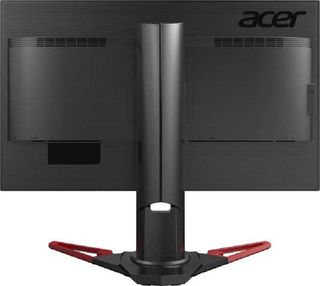
Acer packs internal components into a bulge that occupies about two-thirds of the panel’s backside. It’s well-ventilated and we had no heat-related issues during our tests. The tiny two-watt speakers fire out the rear of the vents shown in the photo. Sound quality will be affected by what’s behind the monitor, especially if you hang it on a wall. The OSD includes a DTS option which helps improve tonal balance, but the speakers are too small to have much frequency range. Volume is reasonable, but you’ll get better results from plugging in a pair of headphones.

G-Sync requires using the single DisplayPort input. The HDMI input is version 1.4 so it will support 3840x2160 resolution but only up to 30Hz. To the right of those you can see the headphone jack and the remaining USB ports.
Current page: Packaging, Physical Layout And Accessories
Prev Page Introduction Next Page OSD Setup And CalibrationStay on the Cutting Edge
Join the experts who read Tom's Hardware for the inside track on enthusiast PC tech news — and have for over 25 years. We'll send breaking news and in-depth reviews of CPUs, GPUs, AI, maker hardware and more straight to your inbox.

Christian Eberle is a Contributing Editor for Tom's Hardware US. He's a veteran reviewer of A/V equipment, specializing in monitors. Christian began his obsession with tech when he built his first PC in 1991, a 286 running DOS 3.0 at a blazing 12MHz. In 2006, he undertook training from the Imaging Science Foundation in video calibration and testing and thus started a passion for precise imaging that persists to this day. He is also a professional musician with a degree from the New England Conservatory as a classical bassoonist which he used to good effect as a performer with the West Point Army Band from 1987 to 2013. He enjoys watching movies and listening to high-end audio in his custom-built home theater and can be seen riding trails near his home on a race-ready ICE VTX recumbent trike. Christian enjoys the endless summer in Florida where he lives with his wife and Chihuahua and plays with orchestras around the state.

EKWB issues public apology regarding delayed payments — promises employees and suppliers it will change its ways

Noctua releases low-profile CPU cooler for SFF builds — NH-L12Sx77 has better clearance for RAM, VRM heatsinks

Chinese may be evading Nvidia GPU sanctions with Dell, Gigabyte, and Supermicro servers: Report
-
chumly Bummer about the response times. The other Predators, the x34, z35, and the smaller 16:9 XB270 variants were all on point (less than 15ms absolute input lag).Reply
The world is still not ready for 4k (but getting closer). 2 more years, 2 more years. -
chumly actually now that I'm comparing tom's review to another review on the same monitor, the response time numbers are not adding up. lag of 16 - 32ms, is one to two frames of lag at 60Hz, according to TFT central, they call this class 2; class 1 (less than 16ms) being optimal for gaming. They have this same exact monitor with only 4ms between signal process and pixel post (much much faster). What's up? Your response time numbers seem to be a lot higher than they should be.Reply -
picture_perfect ReplyWe think motion quality is more important than resolution. When you move up to 75Hz and beyond, things like motion blur fade into the background. Those kinds of artifacts no longer distract from gameplay. With adaptive refresh, tearing is a thing of the past at any resolution, but we’d still rather have those high framerates. So do those extra pixels make up for this? We’d have to say no at this point.
YES. This is an opinion gamers need to know before buying a 4K monitor and one that has been missing from your previous reviews. KUDOS for finally dishing out some common sense. These resolutions are too high. -
eklipz330 Reply
that prediction falls in line with mine... but for me, that means it's an excellent time to buy a "stop gap" monitor now.18177986 said:Bummer about the response times. The other Predators, the x34, z35, and the smaller 16:9 XB270 variants were all on point (less than 15ms absolute input lag).
The world is still not ready for 4k (but getting closer). 2 more years, 2 more years.
3440x1440, 120hz, OLED HDR 34" monitors with low latency to be a thing in 2-3 years. but until we have the hardware to drive that resolution, it makes no sense to wait. i think a 35" 2560x1080 144hz VA panel is amazing right now (for gaming).
-
Sam Hain For me (and this is just my opinion and gaming needs), I cannot justify 4K 60Hz, regardless of price-point, monitor size, response times, manufacturer, etc. at the moment...Reply
Perhaps 4K w/GSync, hitting 100Hz and we have a winner... But of course, then comes that killer price tag. -
ubercake I had this monitor for a day and returned it because of the backlight bleed. It was equivalent of the poor viewing angles you see on a TN monitor because the bottom right corner was very bleached out unless you physically moved your head to center on the bottom right corner.Reply
I then picked up a PG279Q which has less backlight bleed.
I found both monitors to have great performance, but found the backlight bleed on both to be distracting.
I really don't think either Asus or Acer is where they need to be when they charge $800 for a 1440p IPS monitor. These panels may perform well, but they are not great IPS panels from a backlight bleed standpoint. They should be priced around $500 because of the low-end IPS panels. You know what I mean if you've used a good IPS panel.
Hopefully, they'll stop ripping people off one day. -
Sam Hain Reply
In your XP, would Asus build-quality stand as being "better" or does another manufacturer in this realm of gaming-spec monitors stand out in your opinion? I'm not in the market yet... BUT am getting close. Thanks!18179002 said:I had this monitor for a day and returned it because of the backlight bleed. It was equivalent of the poor viewing angles you see on a TN monitor because the bottom right corner was very bleached out unless you physically moved your head to center on the bottom right corner.
I then picked up a PG279Q which has less backlight bleed.
I found both monitors to have great performance, but found the backlight bleed on both to be distracting.
I really don't think either Asus or Acer is where they need to be when they charge $800 for a 1440p IPS monitor. These panels may perform well, but they are not great IPS panels from a backlight bleed standpoint. They should be priced around $500 because of the low-end IPS panels. You know what I mean if you've used a good IPS panel.
Hopefully, they'll stop ripping people off one day.
-
AlistairAB At bestbuy.ca this monitor is $1288 after tax in Canada and the LG 27UD68 is $616. Swap freesync for gsync and save over 600 dollars and you get the same quality panel (or is the LG a higher quality one?) I wish I could spread the gospel of the LG monitor faster, as hardly any sites are mentioning the first inexpensive freesync 4k monitor has arrived, making the price points of all the older ones obsolete.Reply